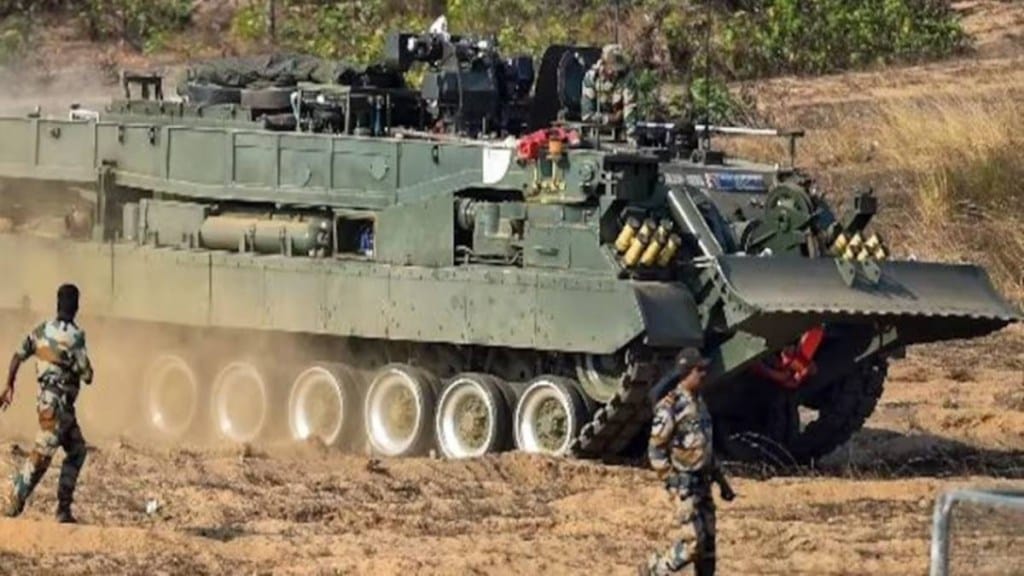To bolster India’s defence capabilities, the Ministry of defence has initiated the procurement of 170 Armoured Recovery Vehicles (ARVs) based on a tracked platform. This move, announced on September 5, 2023, is a part of the government’s commitment to the ‘Make in India’ and ‘Atmanirbhar Bharat’ initiatives, stressing self-reliance and indigenous production.
These ARVs will play a crucial role in ensuring the operational readiness of the Indian Army, particularly in challenging terrain and weather conditions. The procurement process has already begun with the issuance of a Request for Information (RFI), aiming to finalize the Standard Qualitative Requirements (SQRs), determine the procurement category, and identify potential Indian vendors capable of supplying ARVs within a tight timeline of two years from the Award of Contract/Supply Order, with a minimum requirement of 50 ARV vehicles per year.
The operational requirements for these ARVs are extensive. They must be equipped to navigate diverse terrains, from plains and deserts along the Western Borders to high-altitude mountainous regions found along the Northern Borders of India. Moreover, they need to operate perfectly day and night, under various weather conditions, including snowy, rainy, dusty, and sandy environments. These vehicles must also withstand extreme temperature ranges, from as low as -20°C to as high as 45°C, depending on the terrain.
The primary function of these ARVs is to provide repair and recovery cover to disabled Armoured Fighting Vehicles (AFVs) during hostile operations. They will be configured on tracked chassis, ensuring mobility across different terrains. These vehicles will have a carrying capacity of at least six persons, including the driver and commander, and will be equipped with essential utility tools such as cranes, dozers, winches, general tools, special maintenance tools, and ancillary equipment required for repair and recovery missions.
The service life of these ARVs is expected to be a minimum of 32 years, with the possibility of one major overhaul or repair intervention. They must also be transportable through various means, including existing in-service tank transporter vehicles of the Indian Army, transport aircraft of the Indian Air Force, and broad-gauge railway military bogeys.
These ARVs are crucial components in the maintenance and support of Main Battle Tanks (MBTs) like the ‘Arjun.’ They facilitate efficient and speedy repair and recovery operations during combat situations.
The Defence Research and Development Organisation (DRDO) has collaborated with state-owned Bharat Earth Movers Limited (BEML) to manufacture them for the Indian Army. These vehicles have impressive lifting and pulling capacities, ensuring their effectiveness in the field.
Currently, BEML-built ARVs, based on Russian-made T-72 tank hulls, are in use, armed with a 12.7mm machine gun and equipped with powerful cranes capable of lifting up to 15 tons. Additionally, there are upgraded variants like the WZT-3M, produced in collaboration with Polish company Bumar. These ARVs, also known as ARV-3 in the Indian Army, have proven their worth in recovery operations.
These versatile vehicles are designed to recover damaged MBTs, tracked armoured vehicles, and heavy vehicles from the battlefield. They are equipped with tools for minor field repairs and earth-moving projects, enhancing the Army’s self-sufficiency during operations.
Over the years, India has made substantial investments in ARVs, with contracts dating back to 1999. However, as per media reports, a significant order worth US$275 million for 204 ARV-3/WZT-3M vehicles was scrapped in 2012. Despite such setbacks, the Ministry of Defence’s recent initiative to procure 170 ARVs reflects a commitment to maintaining a robust and agile defence infrastructure capable of addressing diverse operational challenges.
In conclusion, the procurement of Armoured Recovery Vehicles marks a pivotal step in enhancing India’s defence capabilities. These vehicles will provide invaluable support to the Indian Army, ensuring the swift recovery and repair of combat assets under challenging conditions. The ‘Make in India’ and ‘Atmanirbhar Bharat’ initiatives continue to drive self-sufficiency and innovation in India

